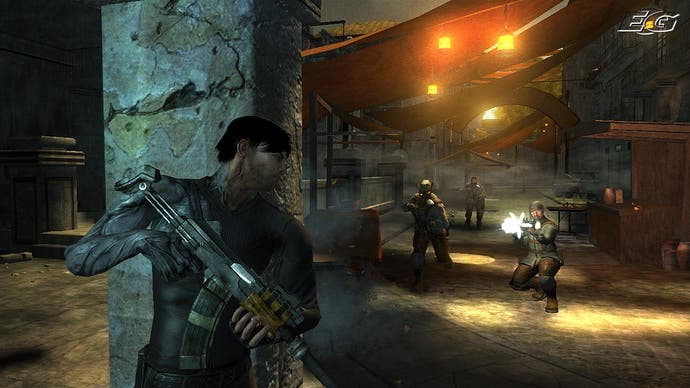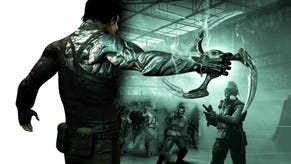Dark Sector
Glaive consequences.
It's never a good sign when a game spends years in development. It's never a good sign when the game's concept changes almost entirely over the course of those years. It's never a good sign when the game is finally released and everyone immediately compares it unfavourably to a game that came out the year before, and it's certainly never a good sign when you play all the way through the game and still have to look up the main character's name on the Internet.
There aren't, as you've probably guessed, many good signs for Dark Sector.
It's a third-person action game in which you play Hayden Tenno (thanks Wikipedia!), a US special agent sent into a former Soviet state to prevent a madman from distributing a biological contagion. You get infected, you get a funky mutated arm, you get superpowers. These include the glaive, which sprouts spontaneously from your hand. A glaive is actually a medieval pole weapon, but the developers clearly preferred bone-headed 1980s Star Wars knock-off Krull to actual history lessons, and so we get a bladed Frisbee thing instead.
You'd better make the most of it because, as with Stranglehold and Assassin's Creed, this is a game that boasts one interesting gameplay feature and proceeds to spend the following six-to-eight hours forcing you to repeat it.
You throw the glaive with the right shoulder button and, as you progress through the game, you gain new abilities to go along with it. The first upgrade allows you to use the glaive to retrieve objects and ammo from a distance. Later you get to control the glaive in flight, guiding it in slow motion to your target. You can even do a "power throw", which is strong enough to cut enemies into bloody chunks.
It can also pick up elemental properties, such as fire, electricity and ice, allowing you to burn, zap or freeze enemies. This ability is also used for sporadic puzzles, in which you have to open a door or remove an obstacle by throwing a suitably charged glaive at the appropriate bit of scenery. These bits are so ploddingly obvious, rarely requiring you to do anything more than scour your immediate surroundings, that the word "puzzle" feels like overkill.

But the glaive is a nifty concept, and one that is undeniably fun to use. At least to start with. Having come up with this one good idea, the developers seem reluctant to really follow through with it. For instance, your environmental interactions are minimal at best. This is the sort of game where you can unload a shotgun into a desk lamp without it moving, and it comes as a real shame to discover that your use of the glaive's elemental powers is restricted by the largely physics-free world.
You can charge it with electricity from malfunctioning strip lights, but you can't smash a working strip light to get some electricity. An icy glaive can put out fires and freeze water spouts into frozen pillars for cover, but you can't use a burning glaive to melt these pillars should an enemy duck behind one. You can't use it to smash, cut or topple anything.
It's not all about the glaive though. You can pick up guns from defeated foes, but as you're infected they self-destruct soon afterwards. If you want a permanent arsenal, you must find cash in-game and then drop down manholes to access the "black market". Here you can buy new guns, and beef them up with a small selection of upgrades. It's much like Resident Evil 4, but a fairly inflexible system. You can't see the effect of an upgrade until you install it, and once installed it can't be removed. The glaive is such a ludicrously over-powered weapon that firearms are almost an afterthought and, like most of the game's ideas, this side of things feels half-baked.
So you run into a new area, and - lo and behold - chunks of masonry or toppled furniture are strewn about, almost as if somebody was anticipating a firefight and thought it'd be nice for everyone to have somewhere to seek shelter. You run in from one end, enemies appear at the other, and you attach to the nearest cover, popping out to either shoot them or (more likely) take them down with a series of slo-mo glaive throws. You can roll from one cover spot to another, or make a dash across open ground.



